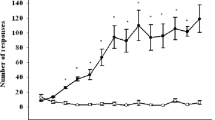Abstract
The effects of intracerebroventricular (icv) agonists and antagonists of N-methyl-D-aspartate (NMDA) and alpha-amino-3-hydroxy-5-methyl-4-isoxazole-propionic acid (AMPA) receptors on the general anesthesia of propofol were studied. A total of 144 Kunming mice, male and female with body mass of (22±3) g, were used. Part One of the Experiment: a total of 104 Kunming mice, male and female, were randomly divided into 13 groups. Intracerebroventricular artificial cerebral fluid (aCSF) or different doses of NMDA, AMPA, MK-801 or NBQX was injected immediately after intravenously administered propofol 25 mg/kg and the recovery time following the loss of righting reflex (LORR) was recorded. Part Two of the Experiment: a total of 40 Kunming female mice were divided randomly into 5 groups and injected with icv aCSF or NMDA, AMPA, MK-801 or NBQX after intraperitoneally administered propofol 50 mg/kg. The pain threshold of the mice was then investigated by hot-plate test (HPPT). NMDA (0.05 or 0.075μg, icv) or AMPA (0.05 μg, icv) exhibited no effects on the LORR, but NMDA (0.1 μg, icv) or AMPA (0.075 or 0.1 μg, icv) prolonged the LORR significantly compared with the aCSF group (P<0.05, P<0.01). The LORR of the 2 μg MK-801 group had no changes, while those of the 4 or 8 μg MK-801 groups were prolonged significantly. The LORR of the 0.5, 2 or 4 μg NBQX groups were all prolonged significantly. NMDA 0.05 μg or AMPA 0.05 μg decreased the pain threshold slightly but did not differ in effect compared with the aCSF group; 2 μg MK-801 or 0.5 μg NBQX both increased the pain threshold significantly. Our results indicate that propofol produces general anesthesia partly through an interaction with brain NMDA and AMPA receptors in mice.
Similar content being viewed by others
References
Sawada S, Yamamoto C. Blocking action of pentobarbital on receptors for excitatory amino acids in the guinea pig hippocampus. Exp Brain Res, 1985, 59(2): 226–231
Twombly D A, Herman M D, Kye C H, Narahashi T. Ethanol effects on two types of voltage activated calcium channels. J Pharmacol Exp Ther, 1990, 254(3): 1029–1037
Bertlik M, Orser B A, Wang L Y, MacDonald J F. Propofol selectively inhibits the NMDA subtye of glutamate receptor. Can J Anesth, 1994, 41: A6
Zhu H, Cottrell J E, Kass I S. The effect of thiopental and propofol on NMDA-and AMPA-mediated glutamate excitotoxicity. Anesthesiology, 1997, 87(4): 944–951
Orser B A, Bertlik M, Wang L Y, MacDonald J F. Inhibition by propofol (2,6 di-isopropylphenol) of the N-methyl-D-aspartate subtype of glutamate receptor in cultured hippocampal neurons. Br J Pharmacol, 1995, 116(2): 1761–1768
Xu A J, Duan S M, Zeng Y M. Effects of intrathecal NMDA and AMPA receptors agonists or antagonists on antinociception of propofol. Acta Pharmacol Sin, 2004, 25(1): 9–14
Bansinath M, Shukla V K, Turndorf H. Popofol modulates the effects of chemoconvulsants acting at GABAergic, glycinergic, and glutamate receptor subtypes. Anesthesiology, 1995, 83(4): 809–815
Zimmermann M. Ethical guidelines for investigations of experimental pain in conscious animals. Pain, 1983, 16(1): 109–110
Xu S Y, Bian R L, Chen X, ed. Methodology of Pharmacological Experiments. 3rd ed. Beijing: People’s Medical Publishing House, 2002, 184: 886–887
Zhang C Y, Zhu T J, Hu G X, Chen X Y, Liu D X, Chen Z K. Effect of sodium dimercaptopropanesulfonate on antagonism of tetramethyl enedisulphotetra mine to GABA receptor. Acta Pharmacol Sin, 2001, 22(5): 435–439
Irifune M, Takarada T, Shimizu Y, Endo C, Katayama S, Dohi T, Kawahara M. Propofol-induced anesthesia in mice is mediated by gamma-aminobutyric acid-A and excitatory amino acid receptors. Anesth Analg, 2003, 97(2): 424–429
Anwar M M, Abdel-Rahman M S. Effect of propofol on perception of pain in mice: mechanism of action. Comp Biochem Physiol A Mol Integr Physiol, 1998, 120(2): 249–253
Hudspith M J. Glutamate: A role in normal brain function, anesthesia, analgesia and CNS injury. Br J Anaesth, 1997, 78(6): 731–747
Kitamura A, Marszalec W, Yeh J Z, Narahashi T. Effects of halothane and propofol on excitatory and inhibitory synaptic transmission in rat cortical neurons. J Pharmacol Exp Ther, 2003, 304(1): 162–171
Wakasugi M, Hirota K, Roth S H, Ito Y. The effects of general anesthetics on excitatory and inhibitory synaptic transmission in area CA1 of the rat hippocampus in vitro. Anesth Analg, 1999, 88(3): 676–680
Grasshoff C, Gillessen T. The effect of propofol on increased superoxide concentration in cultured rat cerebrocortical neurons after stimulation of N-methyl-d-aspartate receptors. Anesth Analg, 2002, 95(4): 920–922
Aanonsen L M, Wilcox G L. Nociceptive action of excitatory amino acids in the mouse: Effects of spinally administered opioids, phencyclidine and sigma agonists. J Pharmacol Exp Ther, 1987, 243(1): 9–19
Lutfy K, Cai S X, Woodward R M, Weber E. Antinociceptive effects of NMDA and non-NMDA receptor antagonists in the tail flick test in mice. Pain, 1997, 70(1): 31–40
Yamakura T, Sakimura K, Shimoji K, Mishina M. Effects of propofol on various AMPA-, kainate-and NMDA-selective glutamate receptor channels expressed in Xenopus oocytes. Neurosci Lett, 1995, 188(3): 187–190
Miller R D. Anesthesia. 5th ed. Harcourt Asia: Churchill Livingstone, 2001, 249–256
Buggy D J, Nicol B, Rowbotham D J, Lambert D G. Effects of intravenous anesthetic agents on glutamate release: A role for GABAA receptor-mediated inhibition. Anesthesiology, 2000, 92(4): 1067–1073
Author information
Authors and Affiliations
Corresponding author
Rights and permissions
About this article
Cite this article
Xu, A., Duan, S. & Tian, Y. Effects of intracerebroventricular NMDA and non-NMDA receptor agonists or antagonists on general anesthesia of propofol in mice. Front. Med. China 1, 207–210 (2007). https://doi.org/10.1007/s11684-007-0039-x
Received:
Accepted:
Published:
Issue Date:
DOI: https://doi.org/10.1007/s11684-007-0039-x




